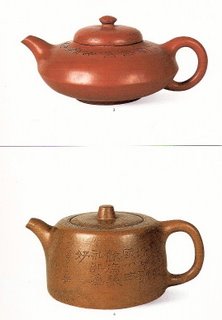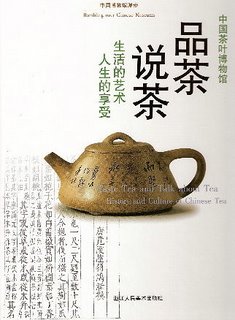 The other day, Teaparker used this 18th Century Zhuni teapot recovered from a shipwreck (traces of salt are still coming out of the clay - sorry for the low quality of the picture). He used it to brew the different oolongs he brought from Fujian and Wu Yi in particular. One of my best tea class. I'm so glad I could make it that day.
The other day, Teaparker used this 18th Century Zhuni teapot recovered from a shipwreck (traces of salt are still coming out of the clay - sorry for the low quality of the picture). He used it to brew the different oolongs he brought from Fujian and Wu Yi in particular. One of my best tea class. I'm so glad I could make it that day.At the end of the class, a friend/acquaintance of Teaparker came by and brought at least half a dozen 'old' Yixing teapots he had on loan from a teapot seller. He wished to have Teaparker's opinion about them. This is an area that I haven't dared to 'touch', yet, because it's so risky and prices can be so high. You could quickly loose your head and spend the kids' tuition fund on a couple of such pieces. Just the one Teaparker used is so light, the lines so fine...
Nevertheless, I thought it useful to listen in to what he had to say. Maybe I can use this information one day (hope is what gets us all going!) And maybe it can help some of you to avoid making a big mistake.
Let's first remember not to pay any attention to the amount of dirt on the teapot. This is easily faked by plunging new teapots in a bathtub filled with water, earth and metal (or if left in water with lots of decaying, humid tea leaves). Like for tea, we don't look at the outside layer (wrappers), but look at the intrinsic value, here the craftsmanship of the teapot. The 3 places to look at are:
1. The handle. It should be a little thinner on top than below. (That's something that I found difficult to see by myself)
2. The knob (the little ball) on top of the lid has a size and shape that's in harmony with the rest of the teapot. The elegance of a teapot can be broken if the proper balance is not there. (I feel this is quite obvious in the examples below)
3. The spout should have some beautiful curves. Like a beautiful woman is well curved, so must be the spout to be a classic antique. The curves were rarely just one, but often several (see bottom left).


 These pictures come from this book from the 'China Tea Museum' from the Mainland. It's all in Chinese, but I still recommend it for its wonderful pictures. (Since I don't own the rights for the pictures, let me advertise it!) The ISBN is 7 - 5340 - 0995 - 2/J.854.
These pictures come from this book from the 'China Tea Museum' from the Mainland. It's all in Chinese, but I still recommend it for its wonderful pictures. (Since I don't own the rights for the pictures, let me advertise it!) The ISBN is 7 - 5340 - 0995 - 2/J.854.I also suggest you look at this other old teapot from Teaparker to see what excellent old design looks like in respect of these 3 places.
Teaparker didn't openly tell him if a teapot is antique or not. He just told him how to look at the teapots. I guess he doesn't want to get into trouble with the seller. To avoid this, he tried to get this person to find out by himself if it was fake or real. (That's how I would feel too, so don't send me any pictures.) However, as that person was taking a break and stepped outside the room, Teaparker shook his head to tell us that none of these were real.
Like with tea, you are the best judge to know what you like or not. Just don't let yourself blind by a date.

I have a question reguarding some of the old pots. Some of them don't come with any filters, so I was wondering if there's any way to substitude them. I know you wrote before about your filterless pot which you cleaned with the toothpick, however I've seen a couple of old pots which had small metal filters in them and I was wondering where can i find some of those. If you have any info, let me know. Thanks
ReplyDeleteYes, I did see some of those filters to add (but forgot where). However, I don't recommend using them. The metal would adversely impact the taste of the tea.
ReplyDeleteOld teapots just have 1 hole. The way to handle it is to use high grade full, unbroken tea leaves. Such leaves won't clog the teapot. You wouldn't want to 'feed' anything else to your precious teapot! (Or would you bring -insert name of your idol- to Mc Donald if your wish for a date were granted?)
Surely there are many antique teapots that are not of a high standard? Does '18th century teapot' automatically mean a good teapot?
ReplyDeleteI think you're making a good point that is similar to what I say about puerh or Oolong: it's not because it's old that it's automatically high quality (and more valuable then new ones).
ReplyDeleteChinese antique ware distinguishes between Min Yao (ordinary people pottery) and Guan Yao (pottery for people with power). Min Yao is very common and low quality. Guan Yao is then the high quality ware. (A third category is pottery for export to Europe or South East Asia.)
Let's then remember that tea in ancient China is like in Japan today: an activity for the rich mostly. This means that the standard/quality for such pots was much higher, especially in Yixing.
These were the luxury items for the rich people of that time. It's a little bit like old paintings in Europe: only the rich would commission such paintings. And artists would spend a lot of time to justify the price they asked.
With mass production, you often hear people saying that things are not as well made as they used to be.
That's what Teaparker meant by giving these keys. Because if you find a very average old teapot, why would you want to pay more. Just because it's old doesn't make sense!
I've recently been looking at Yixing teapots myself but I know almost nothing at all. I've spotted some on eBay claiming to be 19th Century - are these likely to be fake or is it possible they're real?
ReplyDeleteDoug,
ReplyDeleteEverything is possible! But to spot a genuine one at a bargain you would need to be more knowledgeable than the seller. Also, old doesn't necessarily mean good. My advice: beware and learn about teapots.
Hello,
ReplyDeleteI don't know if this forum is still going on, being the last post was in 2007, But I have a old
Yixing Teapot, it has a small bat on it also some kind of tree with fruit. I have no idea it's worth and would love to find out, how do you go about to find out about this. Inside the lid are markings too.